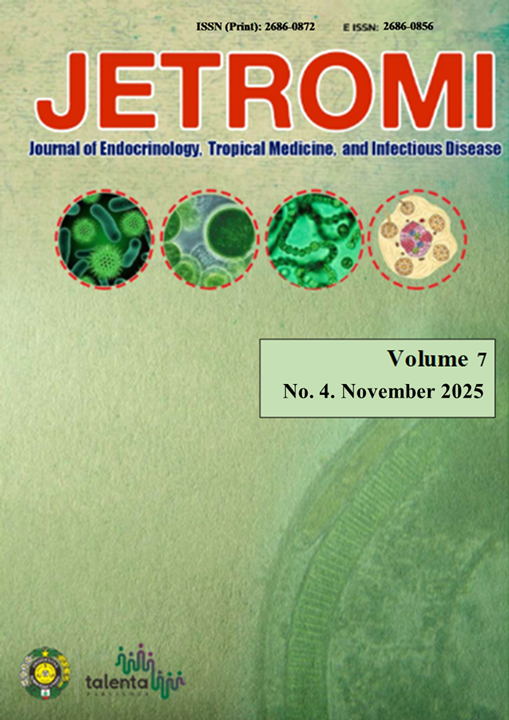Analysis of Differences in Germ Patterns in Pus Culture and Tissue Culture Examination in Patients with Diabetic Foot Ulcers at H. Adam Malik General Hospital, Medan
DOI:
https://doi.org/10.32734/jetromi.v7i4.20207Keywords:
Diabetic foot ulcer, diabetes mellitus, pus culture, tissue culture, bacterial patternsAbstract
Background: Diabetic foot ulcer (DFU) is one of the chronic complications of diabetes mellitus that can increase the risk of amputation and lead to high treatment costs if the infection is not properly managed. Identifying the etiology of the infection is crucial for determining effective treatment. However, in Indonesia, particularly at H. Adam Malik General Hospital in Medan, there has been no clear study focusing on identifying diabetic foot infection patterns based on tissue culture. The Infectious Diseases Society of America (IDSA) 2023 recommends using tissue culture techniques for bacterial identification, moving away from pus cultures. Objective: This study aims to analyze the differences in infection patterns obtained through pus culture and tissue culture in patients with diabetic foot ulcers. Methods: This prospective descriptive study involved 41 patients treated at H. Adam Malik General Hospital, Medan. Ulcer samples were collected using two methods: sterile swabs for pus culture and tissue samples for tissue culture. The culture results were analyzed using the Kruskal-Wallis statistical test to compare the differences in bacterial patterns.
Results: Gram-negative bacteria dominated both culture methods, with Pseudomonas spp being the most common in pus cultures and Escherichia coli in tissue cultures. A significant difference was found between the two methods in bacterial identification (p < 0.05).Conclusion: There is a significant difference between tissue culture and pus culture in diabetic foot ulcers, particularly in the number and types of bacterial isolates, with a p-value of 0.002. This difference is not coincidental, supporting IDSA’s recommendation to prioritize tissue culture over swab culture. These findings are consistent with other studies in the field.
Downloads
Downloads
Published
Issue
Section
License
Copyright (c) 2025 Journal of Endocrinology, Tropical Medicine, and Infectious Disease (JETROMI)

This work is licensed under a Creative Commons Attribution-NonCommercial-ShareAlike 4.0 International License.
The Authors submitting a manuscript do so on the understanding that if accepted for publication, copyright of the article shall be assigned to Journal of Endocrinology, Tropical Medicine and Infectious Diseases (JETROMI).
Copyright encompasses exclusive rights to reproduce and deliver the article in all form and media. The reproduction of any part of this journal, its storage in databases and its transmission by any form or media, will be allowed only with a written permission from Journal of Endocrinology, Tropical Medicine and Infectious Diseases (JETROMI).








